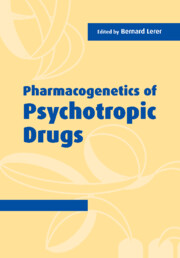Book contents
- Frontmatter
- Contents
- List of contributors
- Part I Introduction
- Part II Clinical background and research design
- 2 From pharmacogenetics to pharmacogenomics of psychotropic drug response
- 3 Neuropsychopharmacology: the interface between genes and psychiatric nosology
- 4 Methodological issues in psychopharmacogenetics
- 5 Statistical approaches in psychopharmacogenetics
- Part III Molecular background
- Part IV Pharmacokinetics
- Part V Specific psychotropic drugs and disorders
- Part VI Pharmacogenetics and brain imaging
- Part VII Industry perspectives
- Index
5 - Statistical approaches in psychopharmacogenetics
from Part II - Clinical background and research design
Published online by Cambridge University Press: 20 August 2009
- Frontmatter
- Contents
- List of contributors
- Part I Introduction
- Part II Clinical background and research design
- 2 From pharmacogenetics to pharmacogenomics of psychotropic drug response
- 3 Neuropsychopharmacology: the interface between genes and psychiatric nosology
- 4 Methodological issues in psychopharmacogenetics
- 5 Statistical approaches in psychopharmacogenetics
- Part III Molecular background
- Part IV Pharmacokinetics
- Part V Specific psychotropic drugs and disorders
- Part VI Pharmacogenetics and brain imaging
- Part VII Industry perspectives
- Index
Summary
OVERVIEW
The statistical analysis of data in psychopharmacogenetics is a key factor in the evaluation of the importance of a gene or of a set of genes in controlling for the response to a given drug or to explain the emergence of a side effect as a consequence of the administered drug. A pharmacogenetic trait is frequently controlled by more than one gene, with different contributions from genes coding for pharmacokinetic traits (absorption, distribution, metabolism, elimination), the ultimate drug target (e.g., receptors, transporters or enzymes), and endogenous ligands. As such, a pharmacogenetic characteristic can be considered a complex trait, with a multifaceted etiology. The best approach to evaluate the genetic bases of a pharmacogenetic trait is the association strategy, where each gene contributing to the expression of the trait conveys only a portion of the overall variability of the characteristic itself. The association strategy conceptually entails the candidate gene paradigm, which is based on a “forward genetics” design. The re-emergence of this analytical approach has become possible as a result of the completion of the sequence for the human genome and the possibility of knowing a priori which genes are involved in the biochemical mechanisms that lead to the drug function. However, several issues must be considered to perform a correct analysis, including a proper definition of the phenotype, a detailed knowledge of the extent and dimension of the genetic variation that is present within and across populations, and the choice of the statistical design.
Keywords
- Type
- Chapter
- Information
- Pharmacogenetics of Psychotropic Drugs , pp. 72 - 92Publisher: Cambridge University PressPrint publication year: 2002
- 1
- Cited by

